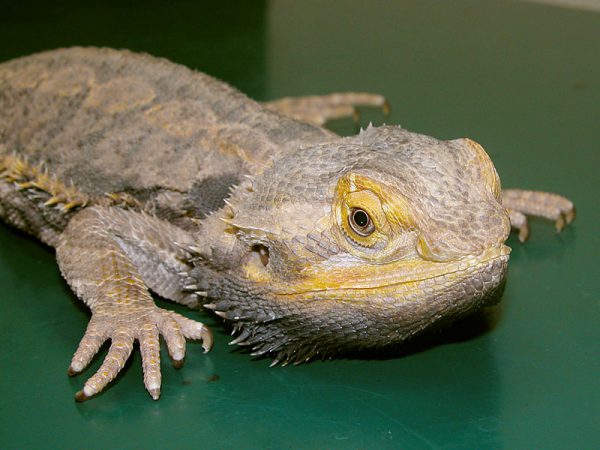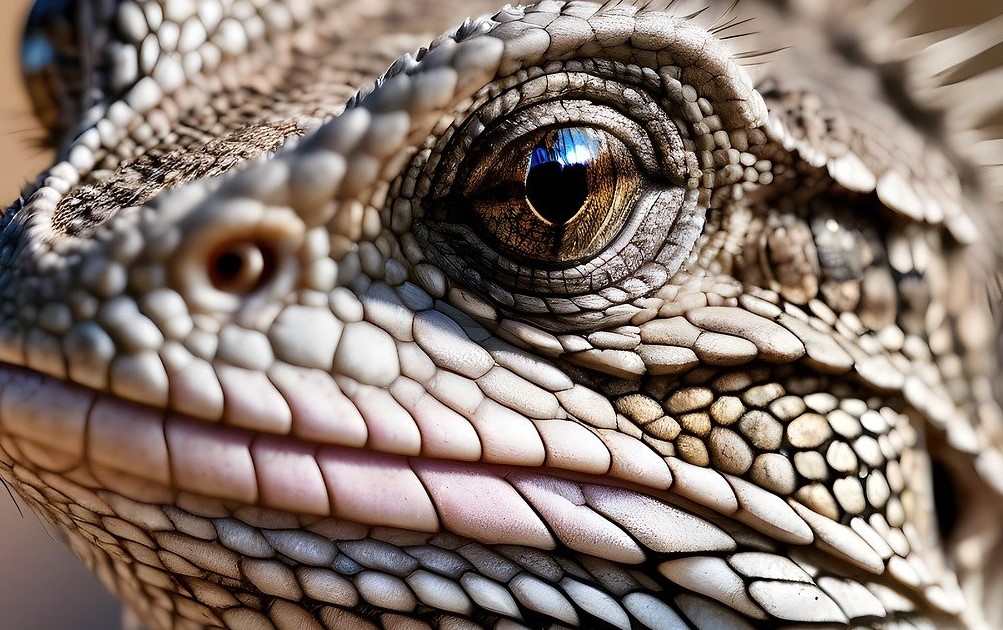目次 [非表示]
特異的行動
多くのトカゲにおいて様々な視覚的なコミュニケーションがとられています。ヘッドボブディスプレイ(Headbob display)〔ボビング:Bobbing〕〔Macedonia et al.2013,Ossip-Klein et al.2013,Ossip-Drahos et al.2018〕ならびにデューラップディスプレイ(Dewlap display)〔Nicholson et al.2007,Driessens et al.2015〕、アームウエイビング(Arm-waving:腕振り運動)(Carpenter et al.1977〕などの特異的な行動、または体色を変化させる(カラーパターン:Colour pattern)〔Klomp et al.2016,Pérez i de Lanuza et al.2014,Pérez i de Lanuza et al.2016〕 等は、相手への視覚的なコミニケーション相互作用とされ、その意味について多くの研究の焦点となってきました。
ヘッドボブディスプレイ(ボビング)
ヘッドボブディスプレイは頭や胴体の定型的な上下運動で〔Carpenter et al.1977〕、フトアゴヒゲトカゲやグリーンイグアナによく見られます。

肉垂が発達しているイグアナでは、デューラップディスプレイとも言われ、肉垂も動かす行動が見られ、色や姿勢の変化、四肢、尾の動きも伴うことも多いです。ヘッドボブディスプレイは、闘争的相互作用ならびに主張、求愛、縄張り防衛など様々な状況で使用されます〔Stamps et al.1973,Carpenter et al.1977,Martins 1991,Decourcy et al.1994, Martins et al.2004)。主張ディスプレイは、周囲にいる他のトカゲに対してトカゲの存在を宣言しているようで、他の個体がいない時にも行われます〔Vicente et al.2015〕。闘争的相互作用である挑戦ディスプレイは、通常、優位なオスが他のオスに対して、敵対的な状況で行います〔Vicente et al.2015〕。フトアゴヒゲトカゲでは、顎下を黒色にしたり(ストレスマーク)、膨らませていると、それは怒りを表しています。このストレスマークはカラーパターンの1つと思われます。

求愛ディスプレイ」は、生殖活動中にオスがメスに対して行われます 〔Carpenter1962,Carpenter et al.1977,Vicente et al.2015〕。縄張り防衛において、他のオスと遭遇すると、ヘッドボブディスプレイ以外にもチャレンジディスプレイと呼ばれる、喉頭領域の膨張、背中の反りなどの威嚇行動も見せます〔Jenssen 1979〕。視覚ディスプレイコミュニケーションに関する研究のほとんどは、アノール〔Jenssen 1977,Jenssen et al.2012〕 と ハリトカゲ〔Carpenter 1978,Martins 1993a, b,Rothblum et al.1978〕 を対象に実施されています。アノールでは、ディスプレイの導入時に幅広いバリエーションがあり、その後種特有のヘッドボブ起こり〔Jenssen1971,Stamps et al.1973〕、他の種類でも、持続時間が長くて振幅が大きい、持続時間が短くて振幅が小さいなど、また威嚇行動が存在せずにヘッドボブディスプレイのみをするなど多様であり、それぞれ意味があると推測されています。なお、フトアゴヒゲトカゲは体調が悪い時も顎下が黒くなります。明らかにぐったりしている時は体調を崩している可能性が高いので要注意です。

アームウエイビング
アームウエイビングは、前腕(片方または交互に)を上げて円を描くように、または波打つように回転させる運動で〔Carpenter et al.1977〕、アガマ科〔Brattstron 1971,Ord et al.2002,Van Dyk et al.2008〕、カナヘビ科〔Font et al.2012〕、テグー科〔Baird et al.2003,Cooper et al.2004〕、アノール科〔Jensen 1979〕、イグアナ科〔Distel et al.1982〕、ツノトカゲ科〔Carpenter1967〕、ヤマイグアナ科〔Halloy et al.2006〕のトカゲで報告されています。フトアゴヒゲトカゲでは片腕前肢ディスプレイが見られ、トカゲは片腕を上下あるいは回転するように動かします。一度動かした後に同じ肢を再び動かしたり、もう片手に替えたり、体の位置を変えたりすることさえあります。

ヤマイグアナ属では、片腕前肢ディスプレイと両腕前肢ディスプレイの 2 種類の腕振りが報告され 〔Halloy et al.2006〕、両腕振り振りは、体が地面に接触した状態で行われ、水泳選手のバタフライ ストロークやクロール ストロークと同様に、両腕を同時にまたは交互に持ち上げます 。ただし、その潜在的解釈は不明で〔Halloy et al.2006〕、雌雄等しく見られる社会的シグナルです。攻撃的または従順なシグナルとして機能するとも推測され〔Van Dyk et al.2008,Woo et al.2012〕、ボビングよりも意義が広い可能性があります。オス同士のやり取りの際、アガマ科のトカゲは、優位性や攻撃性のシグナルとして解釈され、ボビングと組み合わされることもあります〔Brastrom 1971,Van Dyk et al.2008)。しかし、アームウエイビングが低速で表示されると、服従のシグナルとされています〔Woo et al.2013〕。服従の際には、腹部が完全に地面に接触し、頭を下げて、目も閉じた状態で示されます〔Carpenter et al.1977,Labra et al.2007,Hamilton et al.2013〕。また、追跡抑止機能もあると言われています〔Cooper et al.2004,Font et al.2012〕。追跡抑止シグナルとは、捕食者に自分が検出されたこと、または捕食者が追いかけられていることを知らせます。しかし、追跡は捕食されることであり、アームウエイビングをしている最中に食べられてしまう恐れがあります〔Hasson 1991〕。したがって、相手との距離を保ち、自分の位置を明らかにするなどの縄張りのシグナル伝達の意味合いが強いと解釈されています〔Schall 1974,Cooper et al.2004〕。実験でトカゲにある程度離れた距離ではアームウエビングを行います、近づき過ぎると危険回避で逃走します〔Salido et al. 2019〕。
ペットのフトアゴヒゲトカゲでは、野生で持つであろう社会的階層を模倣して、人に対してアームウエビングを行うこともあり得ますが、これがストレス状態を示していることになり、実際に人ではなく、他のペットや部屋の中の大きな家具などの可能性もありますので、原因を突き止めて下さい。トカゲを入れている透明のガラスのケージに自身の反射した姿を見て、その姿に脅威を感じ、服従している可能性もあります。ライトの位置などを変えると、反射しなくなります。幼体が複数で一つのケージに入れられた時に、互いの意思表示でアームウエービングをします。縄張りを主張するというより、同居個体に対して少し離れてくれという拒否的な意思表示のようです。
まとめ
ポーカーフェイスのフトアゴヒゲトカゲですが、ボビングやアームウエービングなどの意思表示もします。人に馴れるトカゲなので、彼らの意思を尊重してストレスのない飼育を心掛けたいですね。
参考文献
- Baird TA et al.Social behavior and sexual dimorphism in the Bonaire whiptail,Cnemidophorus murinus (Squamata:Teiidae): the role of sexual selection.Canadian Journal of Zoology81:1781‐1790.2003
- Brastrom BH.Social and thermoregulatory behavior of the Bearded Dragon,Amphibolurus barbatus.Copeia:484‐497.1971
- Carpenter CC.Display patterns of the Mexican iguanid lizards of the genus Uma.Herpetologica23:285-293.1967
- Carpenter CC.Patterns of behavior in two Oklahoma lizards.The American Midland Naturalist67:132‐151.1962
- Carpenter CC,Ferguson GW.Variation and evolution of stereotyped behavior in reptiles.In Biology of the Reptilia: Ecology and Behaviour A.Gans C,Tinkle DW.eds.Academic Press.New York:335‐554.1977
- ■Carpenter CC.A comparative display behavior in the genus Sceloporus (Iguanidae).Milwaukee Public Museum Contributions in Biology and Geology18:1–71.1978
- ■Cooper WE,Pérez-Mellado V,Baird TA,Caldwell JP et al.Pursuit deterrent signalling by the Bonaire whiptail lizard nemidophorus murinus. Behaviour141:297-311.2004
- ■Cooper WE et al.Pursuit deterrent signalling by the Bonaire whiptail lizard Cnemidophorus murinus.Behaviour141(3):297-311.2004
- Decourcy KR,Jenssen TA.Structure and use of male territorial headbob signals by the lizard Anolis carolinensis.Animal Behaviour47:251-262.1994
- Distel H,Veazey J.The behavioral inventory of the green iguana, Iguana iguana.In Iguanas of the world.Their behavior,ecology, and conservation.Burghardt GM,Rand AS eds. New Jersey:Noyes Publications:p252-270.1982
- Driessens T,Huyghe K,Vanhooydonck B,Van Damme R.Messages conveyed by assorted facets of the dewlap,in both sexes of Anolis sagrei.Behavioral Ecology and Sociobiology69:1251–1264.2015
- Font E,Carazo P,Pérez i de Lanuza G,Kramer M.Predator-elicited foot shakes in wall lizards (Podarcismuralis):Evidence for a pursuit-deterrent function.Journal of Comparative Psychology126:87-96.2012
- Halloy M et al.Forelimb wave displays in lizards species of the genus Liolaemus (Iguania:Liolaemidae).Herpetological Natural History9:127–133.2006
- Hamilton D,Whiting M,Pryke S.Fiery frills:Carotenoid-based coloration predicts contest success in frillneck lizards. Behavioral Ecology24:1138-1149.2013
- Hasson O.Pursuit-deterrent signals:communication between prey and predator.Trends in Ecology and Evolution6(10):325-329.1991
- Jenssen TA.Display analysis of Anolis nebulosus (Sauria, Iguanidae).Copeia:197-209.1971
- Jenssen TA.Display modifiers of Anolis opalinus (Lacertilia: Iguanidae).Herpetologica35:21-30.1979
- ■Jenssen TA,Garrett S,Sydor WJ.Complex signal usage by advertising male green anoles (Anolis carolinensis):A test of assumptions.Herpetologica68:345–357.2012
- ■Klomp DA,Ord TJ,Das I,Diesmos A,Ahmad N,Stuart-Fox DM.Ornament size and colour as alternative strategies for elective communication in gliding lizards.Journal of Evolutionary Biology29(9):1689-1700.2016
- Labra A,Carazo P,Desfilis E,Font E.Agonistic interactions in a Liolaemus lizard:Structure of head bob displays.Herpetologica 63:11-18.2007
- Macedonia JM,Clark DL,Riley RG,Kemp DJ.Species recognition of color and motion signals in Anolis grahami:Evidence from responses to lizard robots.Behavioral Ecology24(4):846-852.2013
- Martins EP.Contextual use of the push-up display by the sagebrush lizard,Sceloporus graciosus.Animal Behaviour45:25-36.1993a
- Martins EP.A comparative study of the evolution of Sceloporus push-up displays.The American Naturalist142:994-1018.1993b
- Martins EP.Individual and sex differences in the use of push-up display by the sagebrush lizard,Sceloporus graciosus.Animal Behaviour41:403-416.1991
- Martins EP,Labra A,Halloy M,Thompson JT.Large-scale patterns of signal evolution:an interspecific study of Liolaemus lizard headbob displays. Animal Behaviour68:453-653.2004
- Nicholson KE,Harmon LJ,Losos JB.Evolution of Anolis lizard dewlap diversity.PLoS ONE2:1-12.2007
- Ord TJ,Peters RA,Evans CS,Taylor AJ.Digital video playback and visual communication in lizards.Animal Behaviour63:879–890.2002
- ■Ossip-Drahos AG,Berry NJ,King CM,Martins EP.Information-gathering as a response to manipulated signals in the eastern fence lizard,Sceloporus undulatus.Ethology124:684-690.2018
- ■Ossip-Klein AG,Fuentes JA et al.Information content is more important than sensory system or physical distance in guiding the long-term evolutionary relationships between signaling modalities in Sceloporus lizards.Behavioral Ecology and Sociobiology67:1513-1522.2018
- ■Pérez i de Lanuza G,Carazo P,Font E.Colours of quality: structural (but not pigment) coloration informs about male quality in a polychromatic lizard.Animal Behaviour90:73-81.2014
- Pérez i de Lanuza G,Font E.The evolution of colour pattern complexity: Selection for conspicuousness favours contrasting within-body colour combinations in lizards.Journal of Evolutionary Biology29:1-10.2016
- Rothblum L.Jenssen TA.Display repertoire analysis of Sceloporus undulatus hyacinthinus (Sauria:Iguanidae) from south-western Virginia.Animal Behaviour26:130-137.1978
- Stamps JA,Barlow GW.Variation and stereotypy in the displays of Anolis aeneus (Sauria:Iguanidae).Behaviour47:67-94.1973
- Schall JJ.Population structure of the Aruban Whiptail Lizard, Cnemidophorus arubensis,in varied habitats. Herpetologica30:38-44.1974
- Salido CA,Vicente NS.Sex and refuge distance inuence escape decision in a Liolaemus lizard when it is approached by a terrestrial predator. Behaviour156.2019
- Van Dyk,DA,Evans CS.Opponent assessment in lizards: Examining the eleect of aggressive and submissive signals.Behavioral Ecology19:895–901.2008
- ■Vicen NS.Arm-wave display in a Liolaemus lizard.Herpetological Journal29:146-150.2019
- ■Vicente N,Halloy M.Male headbob display structure in a neotropical lizard,Liolaemus pacha (Iguania:Liolaemidae): relation to social context.Herpetological JournalVolume25:49–53.2015
